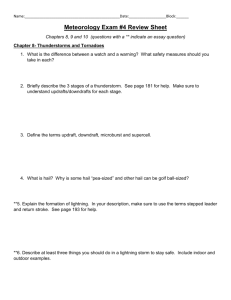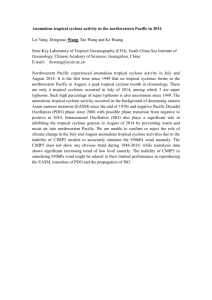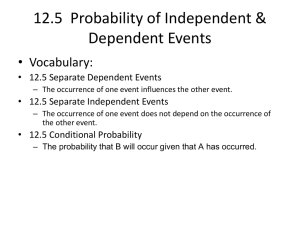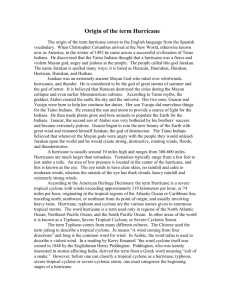NPOESS Applications to Tropical Cyclone Analysis and Forecasting
advertisement
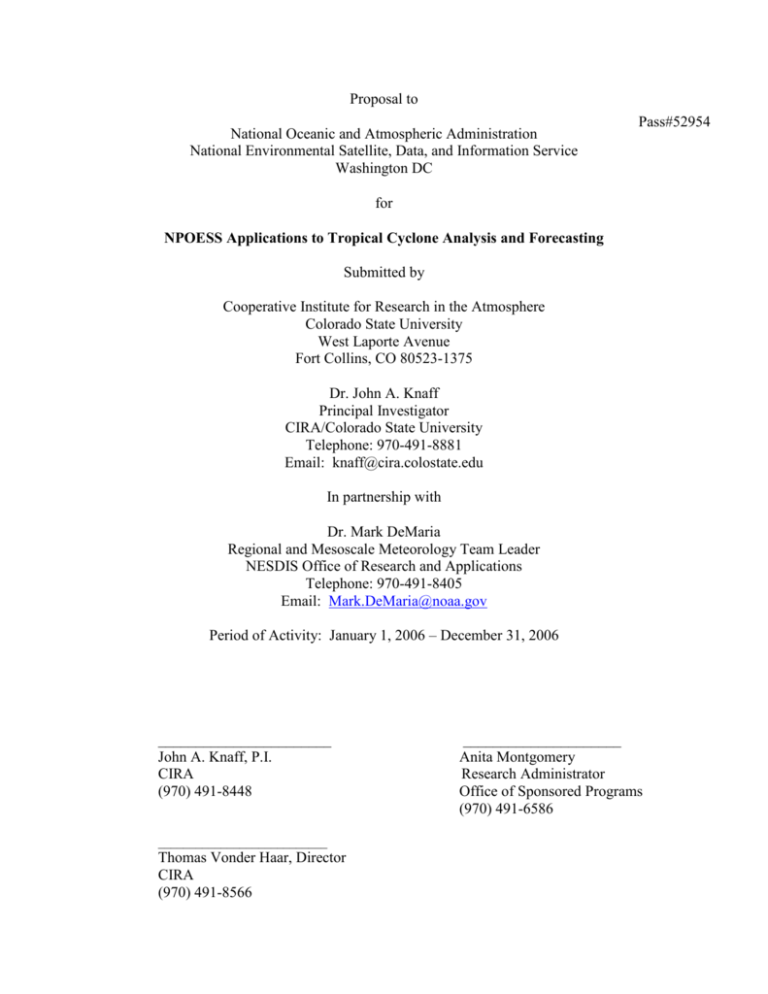
Proposal to National Oceanic and Atmospheric Administration National Environmental Satellite, Data, and Information Service Washington DC Pass#52954 for NPOESS Applications to Tropical Cyclone Analysis and Forecasting Submitted by Cooperative Institute for Research in the Atmosphere Colorado State University West Laporte Avenue Fort Collins, CO 80523-1375 Dr. John A. Knaff Principal Investigator CIRA/Colorado State University Telephone: 970-491-8881 Email: knaff@cira.colostate.edu In partnership with Dr. Mark DeMaria Regional and Mesoscale Meteorology Team Leader NESDIS Office of Research and Applications Telephone: 970-491-8405 Email: Mark.DeMaria@noaa.gov Period of Activity: January 1, 2006 – December 31, 2006 _______________________ John A. Knaff, P.I. CIRA (970) 491-8448 ___________________________ Thomas Vonder Haar, Director CIRA (970) 491-8566 _____________________ Anita Montgomery Research Administrator Office of Sponsored Programs (970) 491-6586 1. Introduction To prepare for tropical cyclones (TCs) and mitigate their effects, accurate analyses and forecasts of the track, intensity, wind structure and rainfall are required. TC track forecast errors have decreased significantly over the past several decades, and some modest improvement in intensity forecast skill has occurred in the past few years. The ability to forecast TC wind structure and rainfall have received considerably less attention. The track error reductions are due to improved dynamical models, while the intensity improvements resulted from better dynamical and statistical forecast techniques. Despite these gains, tropical cyclone warnings are still only issued 24 hours in advance. This amount of time is not always long enough for large metropolitan areas, as was so dramatically illustrated in Hurricane Katrina in 2005. Further improvement in TC forecasting will require better measurements of the storm environment and core, advanced tropical cyclone models, and advanced data assimilation techniques to utilize the new data. Product development activities to diagnose the required forecast parameters such as TC wind radii from the data and model fields are also needed. Although the inner cores of TCs have a small spatial scale (100 km or less), the time scale of the track and intensity changes have a fairly long time scale (6 hours or longer). Because of this long time scale, observations from polar orbiting satellites are very well suited to tropical cyclone analysis. The advanced instruments on NPOESS have great potential to contribute to TC forecast improvements. In this proposal, the application of NPOESS data to tropical cyclone analysis and short term forecasting will be demonstrated using proxy data from existing operational and experimental satellites. The utility of the VIIRS instrument for intensity and wind structure diagnosis will be investigated using MODIS and AVHRR observations. The utility of the combined ATMS and CrIS sounding in tropical cyclones will also be demonstrated using proxy data from AIRS/AMSU retrievals from recent tropical cyclones, as well as output from numerical model simulations. The ability to use these sounding in tropical cyclone eyes and well as in the storm environments will be studied. The eye soundings have great promise for intensity monitoring. The soundings surrounding the storm can be used to evaluate the moisture available to the storm (for short term intensity forecasting), and to provide wind structure estimation, though the use of hydrostatic and dynamical constraints. The potential use of the ocean altimeter planned for NPOESS will also be demonstrated by investigating the impact of oceanic heat content determined from current altimeters on tropical cyclone intensity changes. 2. Prototype Tropical Cyclone Products 2.1 VIIRS Applications The VIIRS instrument will provide visible and infrared imagery with horizontal resolution finer than currently available from GOES and the current series of NOAA polar orbiting satellites. Visible and IR imagery has been used at operational forecast centers for the last several decades to monitor tropical cyclone intensity with various versions of the Dvorak technique (e.g., Dvorak 1975). The IR version of the technique is 2 more objective, and relies on the difference between the warm eye temperature and the cold clouds in the eye wall. For tropical cyclones with small eyes, the technique can be limited by the horizontal resolution. In this project, high resolution MODIS and AVHRR data will be used as a proxy for VIIRS. For example, Fig. 1 shows 1 km IR imagery from MODIS of hurricane Lili from the 2002 hurricane season. For comparison, the imagery was degraded to 4 km (the current resolution of GOES). Considerably more detail can be seen in the eye and eye wall region with the finer resolution. In this project, a series of tropical cyclone images from MODIS and AVHRR will be obtained. Companion images will be generated by degrading the resolution to that of the current GOES and POES satellites. The impact on the Dvorak method, and the more general IR tropical cyclone wind structure algorithm described by Mueller et al (2006) will be evaluated. 2.2 ATMS/CrIS Applications The combined microwave and infrared sounders planned for NPOESS will provide temperature and moisture retrievals with unprecedented accuracy. Proxy data from AIRS/AMSU will be used to illustrate the utility of ATMS/CrIS for tropical cyclone analysis. In the first application, the AIRS/AMSU retrievals will be obtained in hurricane eyes. For weaker systems without clear eyes, the technique will rely on the microwave data from the ATMS. Given an upper boundary condition which can be obtained from an NCEP global analysis, the hydrostatic equation can integrated to the surface using the temperature and moisture sounding to directly estimate the surface pressure. This will provide a new and novel method for monitoring the intensity of tropical cyclones, which will be especially useful in regions such as the Pacific which do not have routine aircraft reconnaissance observations available. As an example of this technique, Fig. 2 shows an eye sounding obtained from a combined AIRS/AMSU retrieval in Hurricane Isabel (2003) from the AQUA satellite. The hydrostatic integration of the eye sounding from 100 hPa to the surface gave a minimum pressure of 936 hPa, which compared well with the 933 hPa measure by aircraft. In the second application, the above method will be generalized to determine TC wind structure. The radius of 50 kt winds is a critical parameter for ship routing, and the 34 ktwind radius is important for coastal evacuations because these must be completed before the arrival of gale force winds. To estimate the outer wind field, the two dimensional geopotential height field near the surface can be estimated from a downward hydrostatic integration. The non-linear balance equation can be used to estimate the wind field above the boundary layer, and then standard surface reduction methods can be used to estimate the surface winds. This application provides an estimate of the entire surface wind field, instead of just a point value of the maximum intensity. 3 Figure 1. Comparison of 1 km (top) and 4 km (bottom) IR imagery for Hurricane Lili on 2 October 2002. 4 Eye - Environment Temperature 100 200 Eye Sounding Environment Sounding Pressure (hPa) 300 400 500 600 700 800 900 1000 0 2 4 6 8 10 12 14 16 18 Temperature Anomaly (C) Figure 2. The location of the combined AIRS/AMSU retrieval in the eye and environment of Hurricane Isabel (left). The temperature difference between the eye and environment sounding is shown on the right and illustrates the classic warm core structure. The wind structure estimation method has already been tested on a few AMSU-based temperature retrievals (Bessho et al 2006), as shown in Figure 3. Results show that the technique has accuracy comparable to QuikSCAT surface wind retrievals, which are extremely useful for operational TC analysis at the National Hurricane Center (NHC) and the Joint Typhoon Warning Center. Although neither technique resolves the inner core, the outer wind field structure can be determined. It is anticipated that the ATMS/CrIS retrievals will have improved horizontal resolution compared to AIRS/AMSU. To investigate the improvement in the wind structure retrieval, the algorithm will also be applied to proxy soundings from numerical hurricane model simulations, with various horizontal filters applied to match the planned resolution of ATMS, and that of the current AMSU resolution. 5 Figure 3. The surface winds for Hurricane Floyd (1999) from QuikSCAT (left) and the AMSU retrieval technique. 2.3 Ocean Altimeter Applications The fact that hurricanes are fueled by heat from the ocean has been known for more than half of a century. However, the depth of the warm water can vary considerably. Thus, the oceanic heat content (OHC), the ocean energy available to the storm, can vary considerably, depending on the subsurface ocean structure. The OHC can be estimated using a combination of sea surface temperature and ocean altimeter measurements. The ocean altimeter planned for NPOESS will be a valuable part of this observing system. Recent results (DeMaria et al 2005) have shown that the OHC input can have an effect on operational tropical cyclone intensity forecasts. In this proposal, OHC estimated from current satellites will be used to identify cases where the ocean impacts were especially important. For example, Fig. 4 shows the operational OHC product from the National Hurricane Center (determined from satellite altimetry) and the track and intensity of Hurricane Katrina from 2005 season. In this case, Katrina reached category 5 intensity (i.e., winds greater than 135 kt) as it passed over a region of very high OHC in the Gulf of Mexico. Investigation of these types of cases will help to highlight the need for altimetry data from NPOESS for operational hurricane intensity forecasting. 6 Figure 4. The ocean heat content estimated from satellite altimetry and the track (circles) of hurricane Katrina from 2005. 3. Relevance to the NPOESS mission Tropical cyclones have a time scale consistent with that of polar orbiting satellites, and the suite of instrumentation planned for NPOESS had great potential for improvement of tropical cyclone analysis and forecasting. Tropical cyclones are costly both in terms property damage and loss of life, and so the improvements in hurricane analysis forecasting from the NPOESS program will have great societal benefit. For nearly all tropical cyclone basins except the Atlantic, reconnaissance aircraft data is not routinely available, so that tropical cyclone monitoring is almost exclusively from satellite data. Thus, NPOESS will be even more important for the interests of the U.S. Department of Defense, who have global tropical cyclone forecast responsibility. In the future, the infrared and microwave sounding information from NPOESS will be included in numerical hurricane models through direct radiance assimilation. However, a number of other diagnostic products will be possible provided that the temperature and moisture fields that are used as input are of sufficient accuracy. This proposal will help to establish the accuracy of the NPOESS algorithms near tropical cyclones, and evaluate the 7 impact on derived intensity and wind structure products that are of interest to operational forecasters. The work will also help to pave the way for operational NPOESS-based tropical cyclone algorithms. 4. Budget Explanation The proposed budget for the first year of this project is $45 K, which will help to support CIRA research associates, a computer programmer and a student assistant. The contribution from M. DeMaria will be provided from NOAA/ORA base funds at no cost to NESDIS. PERSONNEL: 1. Salaries: Base salaries included in this proposal reflect the actual salaries approved by the Governing Board of Colorado State University for the period July 1, 2005 through June 30, 2006. Any salaries beyond this period are budgeted at a 4% increase over the prior year’s annual base. All individuals budgeted are employees of Colorado State University. 2. Fringe Benefits: The following estimated CSU rates were applied to the above salaries based on the individual’s payroll classification. a. Faculty/Administrative Professional b. State Classified c. Student Hourly FY 2005 20.3% 20.5% 1.2% FY 2006 20.3% 21.5% 1.2% TRAVEL: Travel is budgeted based on the successful completion of the project and the proposed dissemination of the research results. Per diem rates are applied when the destination is to a location listed in the CSU per diem/city publication. Airfare and rental car estimates are obtained from state approved travel agencies. The expenses of one trip is budgeted to Miami, FL, for collaboration with the AOML Hurricane Research Division and the National Hurricane Center. SUPPLIES: $500 is budgeted for editing software. The software will be needed to make short highquality movie loops that include sound, narration and animation. This was requested by the Integrated Program Office for project documentation and promotion. OTHER: The CIRA Computer Infrastructure charges provide computer and data support associated with this project, for the use of the computers already available at CIRA. The Computer Infrastructure hourly rate is determined by CIRA and depends on the actual cost of the network/printing, consultation, Linux hardware and maintenance, data and materials. 8 INDIRECT COSTS: An Indirect Rate of 25% is charged on this proposal. This is the negotiated rate for CIRA’s Cooperative Agreement for the period January 1, 2005-June 30, 2006. The rate is applied to Modified Total Direct Costs (MTDC). MTDC is defined as Total Direct Costs less Equipment, GRA Tuition, and Subcontracts > $25,000. References Bessho, K., M. DeMaria and J.A. Knaff, 2006: Tropical cyclone wind retrievals from the Advanced Microwave Sounder Unit (AMSU): Application to surface wind analysis. J. Appl. Meteor, 46, in press. DeMaria, M., M. Mainelli, L.K. Shay, J.A. Knaff and J. Kaplan, 2005: Further Improvements in the Statistical Hurricane Intensity Prediction Scheme (SHIPS). Wea. Forecasting, 20, 531-543. Dvorak, Vernon F. 1975: Tropical Cyclone Intensity Analysis and Forecasting from Satellite Imagery. Mon. Wea. Rev., 103, 420–464. Mueller, K., M. DeMaria, J.A. Knaff and T.H. Vonder Haar, 2005: Objective Estimation of Tropical Cyclone Wind Structure from Infrared Satellite Data. Wea. Forecasting, 21, in press. 9


